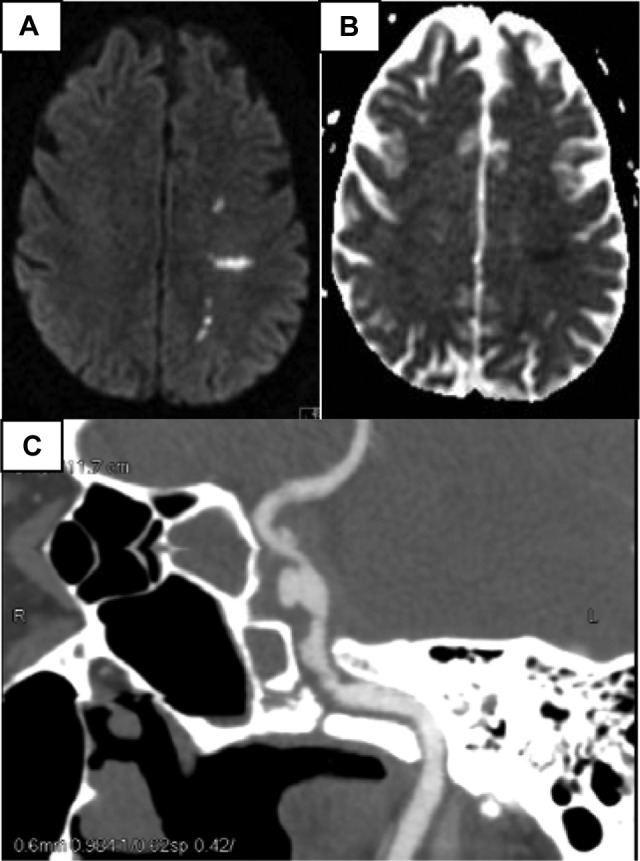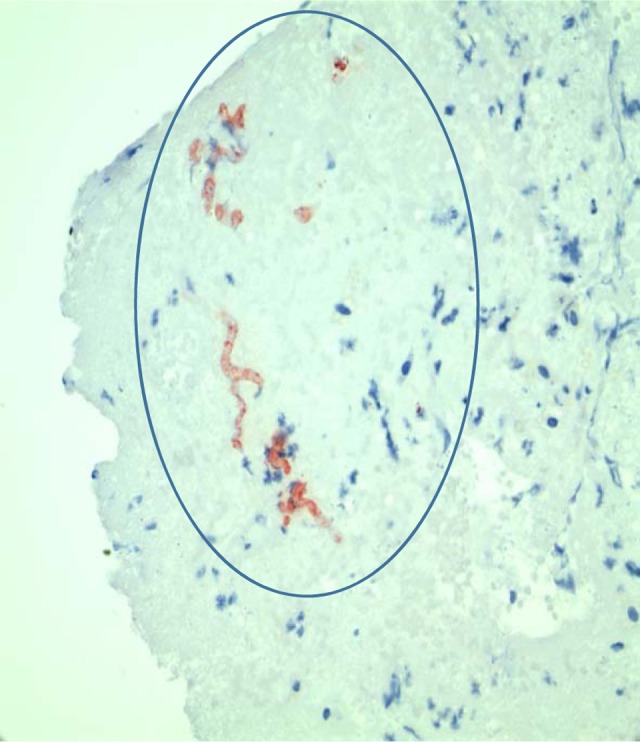Case History
A 60-year-old nondiabetic woman with atrial fibrillation presented with fever, night sweats, and right leg pain. Laboratory testing showed pancytopenia; venous duplex revealed a deep vein thrombosis of the right leg, prompting treatment with rivaroxaban. Bone marrow biopsy showed acute myeloid leukemia (AML). After starting induction chemotherapy with idarubicin and cytarabine, she developed left retro-orbital pain, otalgia, and diplopia. Clinical examination demonstrated left Horner syndrome, cranial nerve V1 and VI palsies, Gerstmann syndrome, and right upper extremity weakness.
Head computed tomography showed opacification of the left sphenoid and posterior ethmoid sinuses (not visualized on computed tomography angiography images presented). Brain magnetic resonance imaging confirmed acute multifocal infarcts within the left interior carotid artery watershed territory (Figure 1A and B). Computed tomography angiogram of the head showed significant multifocal left cavernous internal carotid artery stenosis and extradural mycotic aneurysm formation (Figure 1C). Posterior sphenoid sinus biopsy showed Rhizomucor (Figure 2). Despite extensive surgical debridement and antifungal therapy, the patient deteriorated and comfort measures were pursued.
Figure 1.

Magnetic resonance imaging (MRI; A and B) and computed tomography angiography (CTA) of the head (C). Axial diffusion-weighted imaging (A) and automated-diffusion coefficient (B) MRI and coronal view of the cervical, petrous, cavernous, and supraclinoid segments of the internal carotid artery on CTA of the head (C).
Figure 2.

Pathology specimen—left sphenoid sinus biopsy. Hemorrhage and acute inflammatory cells with intervening aseptate fungal hyphae consistent with Rhizomucor species by immunostain.
Discussion
We describe a case of aggressive mucormycosis with early cavernous sinus involvement, mycotic cavernous carotid aneurysm, cranial neuropathies, and cerebral infarction in a patient with AML.
Mucormycosis primarily manifests in immunocompromised individuals1 and occurs in less than 1% among patients with hematologic malignancies.2 Angioinvasive properties predispose to infarction and necrosis in rhinocerebral and pulmonary disease.3
A high index of suspicion is needed for early detection and management in susceptible patients presenting with sinusitis, periorbital cellulitis, and facial numbness or pain with or without associated ocular cranial neuropathies.4
Footnotes
Declaration of Conflicting Interests: The authors declared no potential conflicts of interest with respect to the research, authorship, and/or publication of this article.
Funding: The authors received no financial support for the research, authorship, and/or publication of this article.
References
- 1. Panackal AA, Williamson PR. Fungal infections of the central nervous system. Continuum (Minneap Minn). 2015;21(6 Neuroinfectious Disease):1662–1678. [DOI] [PubMed] [Google Scholar]
- 2. Cornely OA, Maertens J, Winston DJ, et al. Posaconazole vs fluconazole or itraconazole prophylaxis in patients with neutropenia. N Engl J Med. 2007;356(4):348–359. [DOI] [PubMed] [Google Scholar]
- 3. Ben-Ami R, Luna M, Lewis RE, Walsh TJ, Kontoyiannis DP. A clinicopathological study of pulmonary mucormycosis in cancer patients: extensive angioinvasion but limited inflammatory response. J Infect. 2009;59(2):134–138. [DOI] [PMC free article] [PubMed] [Google Scholar]
- 4. Petrikkos G, Skiada A, Lortholary O, Roilides E, Walsh TJ, Kontoyiannis DP. Epidemiology and clinical manifestations of mucormycosis. Clin Infect Dis. 2012;54(suppl 1):S23–S34. [DOI] [PubMed] [Google Scholar]


